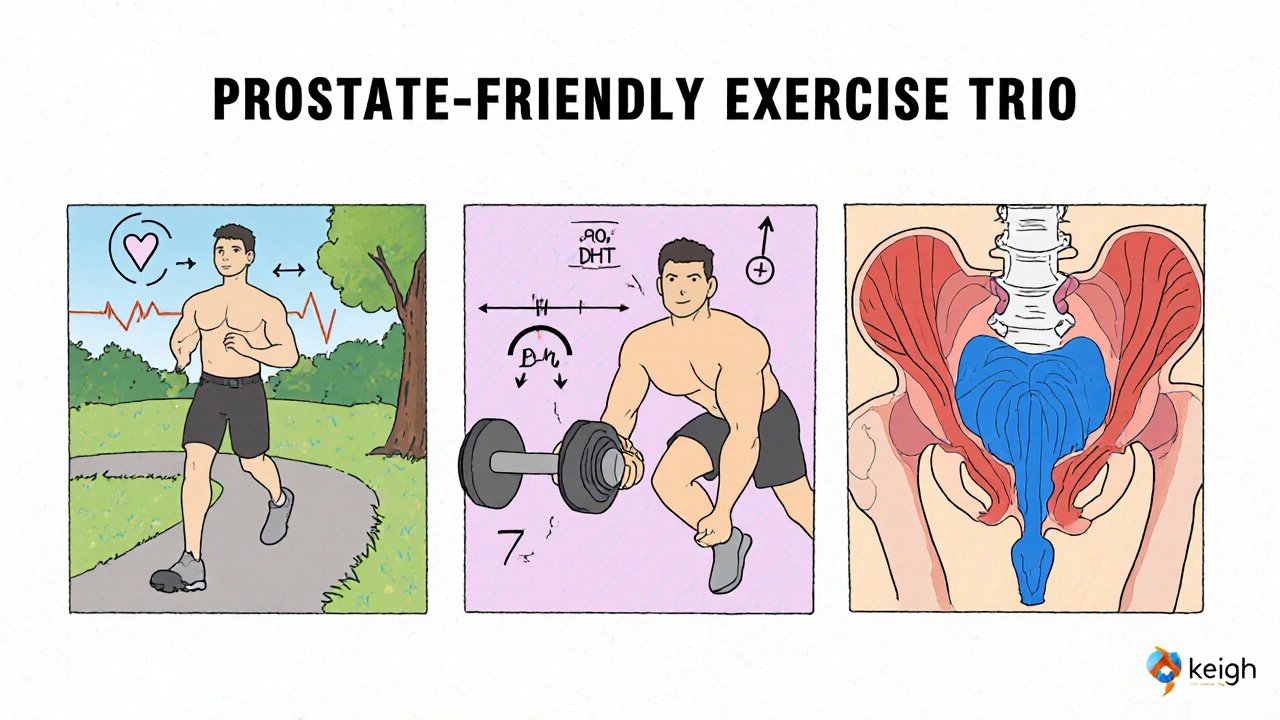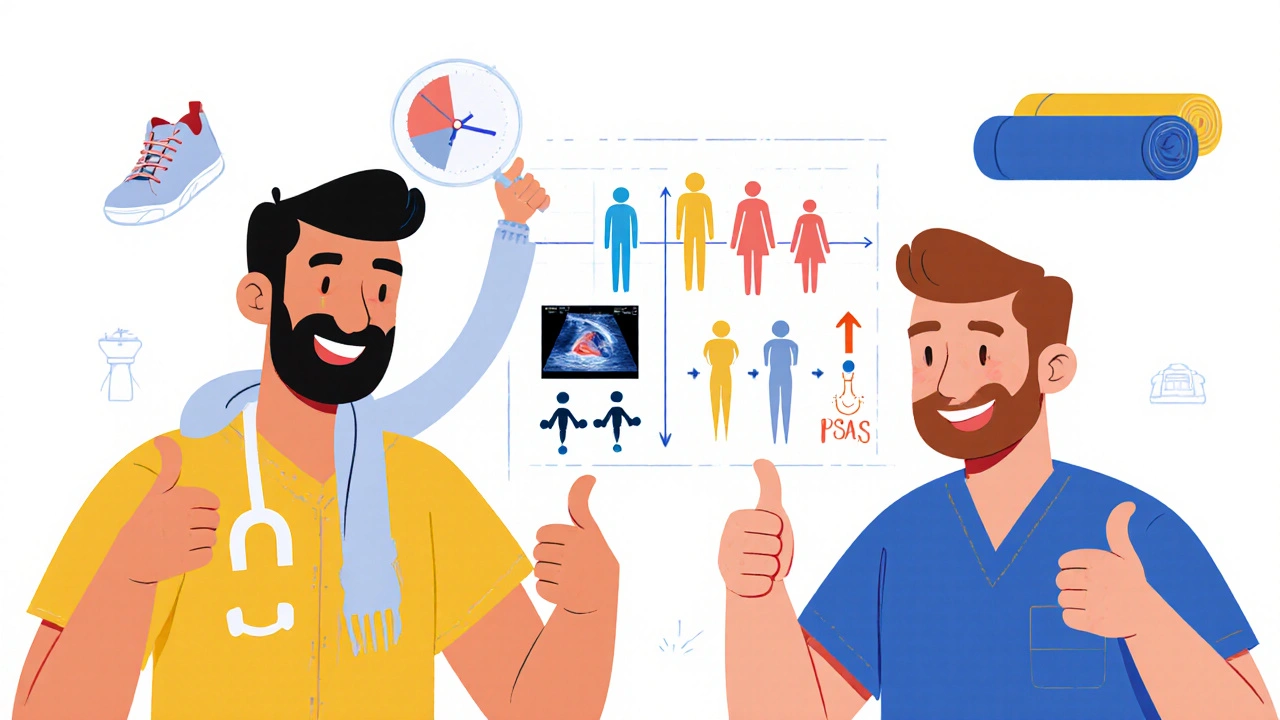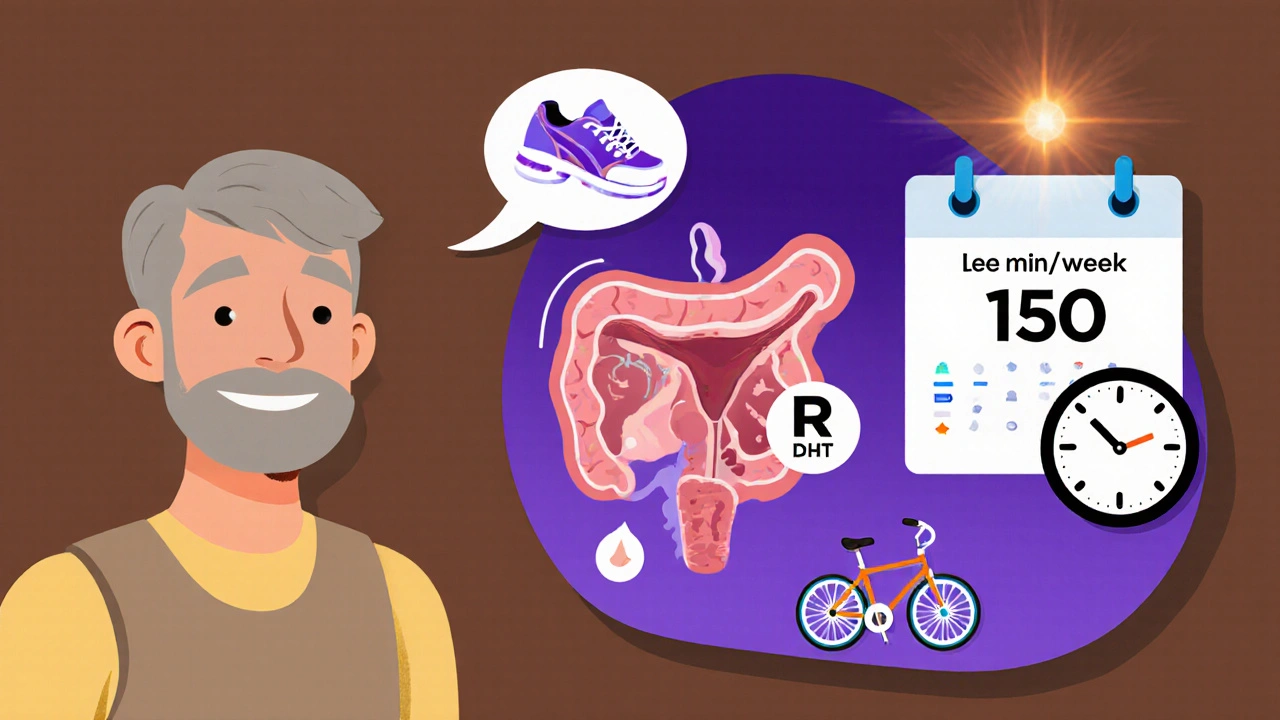Key Takeaways
- Regular exercise can lower hormone levels that fuel prostate growth.
- Aerobic, resistance, and pelvic‑floor workouts each target different symptom triggers.
- Keeping a healthy BMI and staying active reduces urinary urgency and nighttime trips.
- Start with 150 minutes of moderate activity per week; add specific prostate‑friendly moves.
- Track symptoms with a simple journal; consult a doctor if pain or blood appears.
If you’ve heard the term "enlarged prostate" and wondered whether a jog or a set of squats could actually help, you’re not alone. Men over 50 often notice a frequent urge to pee, a weak stream, or the need to get up at night. The good news is that you don’t have to rely solely on medication-your body’s own toolbox, especially movement, plays a big part.
In this guide we’ll break down why physical activity matters, which kinds of workouts hit the sweet spot, and how to turn the advice into a realistic weekly plan. By the end you’ll have a clear roadmap for using exercise to both prevent the onset of prostate issues and keep existing symptoms in check.
Enlarged prostate is a non‑cancerous swelling of the prostate gland, medically known as Benign prostatic hyperplasia (BPH). It gradually blocks the urethra, making it harder to empty the bladder fully. While genetics and age are the biggest risk factors, lifestyle choices-especially activity level-can tip the balance.
Why Exercise Matters for Prostate Health
Scientists have linked regular movement to lower levels of dihydrotestosterone (DHT), the hormone that encourages prostate cells to grow. A 2023 meta‑analysis of 12 randomized trials found that men who logged at least 150 minutes of moderate‑intensity cardio each week saw a 20 % reduction in prostate volume growth compared with sedentary peers.
Exercise also improves blood circulation, which helps the bladder and urethra work more efficiently. Better circulation means the muscles that control urine flow get more oxygen and nutrients, reducing the sensation of urgency.
Finally, staying active helps manage weight. A higher body mass index (BMI) is strongly associated with worsening BPH symptoms because excess fat can increase estrogen levels, indirectly stimulating prostate enlargement.
Body mass index (BMI) is a simple calculation-weight (kg) divided by height squared (m²). Keeping BMI below 25 is a solid target for prostate‑friendly health.
The Best Types of Exercise for BPH Prevention and Management
Not every workout hits the prostate in the same way. Think of the three main categories as a three‑leg stool; you need all of them for stability.
| Exercise Type | Primary Prostate Benefit | Typical Session Length | Weekly Frequency |
|---|---|---|---|
| Aerobic (e.g., brisk walking, cycling) | Lowers DHT and improves circulation | 30‑45 min | 3‑5 days |
| Resistance training (e.g., weightlifting, body‑weight circuits) | Boosts testosterone balance, preserves muscle mass | 20‑30 min | 2‑3 days |
| Pelvic‑floor strengthening (Kegels, Pilates) | Improves urinary control, reduces urgency | 10‑15 min | Daily |
Aerobic exercise includes any activity that raises heart rate into the moderate zone (about 50‑70 % of max HR). Think brisk walks, light jogging, swimming, or cycling. The key is consistency-your body adapts over weeks, not days.
Resistance training focuses on muscle overload. Using dumbbells, resistance bands, or even your own body weight stimulates hormone regulation and helps keep the prostate from inflaming due to muscle fatigue.
Pelvic floor muscles are the sling that controls urine flow. Targeted Kegel exercises-contracting the muscles you’d use to stop a stream-strengthen that sling and reduce nighttime trips.

Building a Prostate‑Friendly Weekly Routine
- Monday - Cardio Warm‑up: 30‑minute brisk walk or stationary bike at a pace where you can talk but not sing.
- Tuesday - Resistance Circuit: 3 sets of 10‑12 reps of squats, lunges, push‑ups, and rows. Keep rest under 60 seconds to keep heart rate moderate.
- Wednesday - Pelvic‑Floor Focus: 3 sets of 10 Kegel holds. Contract for 5 seconds, relax for 5 seconds. Do this sitting or standing.
- Thursday - Light Cardio: 20‑minute swimming or easy cycling. Aim for a steady, rhythmic pace.
- Friday - Full‑Body Resistance: Repeat Tuesday’s circuit but add a core move like planks (30 seconds).
- Saturday - Flexibility + Pelvic Floor: 15‑minute yoga flow emphasizing hip openers, then finish with another Kegel set.
- Sunday - Rest or Gentle Walk: Stay active with a relaxed stroll; give muscles time to recover.
Adjust intensity based on your fitness level. If 30 minutes feels too much at first, start with 10‑15 minutes and add 5 minutes every week. The goal is to reach at least 150 minutes of moderate cardio by month two.
Tracking Progress and Knowing When to See a Doctor
Keep a simple symptom journal. Note the time you wake up to pee, how strong the stream feels, and any pain or blood. Use a 1‑5 rating for urgency and another for comfort.
If your rating stays above 3 for more than two weeks despite consistent exercise, or if you notice blood, pain, or a sudden inability to start a stream, book an appointment. These could signal infection, stones, or a need for medication.
Routine blood tests that include Prostate‑specific antigen (PSA) levels can also help your doctor gauge whether further investigation is needed.

Common Pitfalls and How to Avoid Them
- Skipping the pelvic floor work. Many men think cardio alone is enough. Without strengthening the muscles that control flow, urgency can persist.
- Overtraining. Pushing too hard can cause inflammation, actually worsening symptoms. Listen to your body; soreness is okay, sharp pain is not.
- Ignoring hydration timing. Drinking large amounts right before bed can trigger nighttime trips. Aim for steady hydration earlier in the day.
- Neglecting weight management. Even modest weight loss (5‑10 % of body weight) can lower PSA and improve flow.
Real‑World Success Stories
Mark, 58, from Bristol, started a 150‑minute weekly walking plan plus daily Kegels after his doctor flagged mild BPH. Within three months his nighttime bathroom trips dropped from six to two, and his PSA fell from 4.2 ng/mL to 3.6 ng/mL.
Anna’s husband, Dave, 62, incorporated resistance bands twice a week. After six months his urinary stream strength improved noticeably, and his doctor reported a 12 % reduction in prostate volume on ultrasound.
Putting It All Together
Exercise isn’t a magic pill, but it’s a powerful, low‑cost tool you can start today. By mixing cardio, strength work, and pelvic‑floor drills, you hit the hormone, circulation, and muscle‑control angles that matter most for an enlarged prostate.
Start small, stay consistent, track what changes, and involve your healthcare provider when needed. Your bladder will thank you, and you’ll likely feel more energetic overall.
How many minutes of exercise are enough to affect prostate health?
Research points to at least 150 minutes of moderate‑intensity aerobic activity per week. That’s about 30 minutes a day, five days a week. Adding two short resistance sessions and daily pelvic‑floor work boosts the benefit.
Can I do high‑intensity interval training (HIIT) if I have BPH?
HIIT can be safe, but start with lower intensity. Sudden spikes in blood pressure may temporarily irritate the prostate. Combine HIIT with a solid warm‑up and finish with gentle stretching.
Do I need special equipment for pelvic‑floor exercises?
No special gear is required. You just need to learn how to isolate the right muscles. If you’re unsure, a quick video tutorial or a physiotherapist’s guidance can help you feel the contraction correctly.
Should I stop exercising if my symptoms get worse?
If you notice a sudden increase in pain, blood in urine, or a sharp drop in stream strength, pause the workouts and see a doctor. Gradual changes are normal; abrupt worsening signals a possible infection or other issue.
Is diet important alongside exercise?
Yes. A diet rich in fruits, vegetables, whole grains, and healthy fats supports hormone balance and reduces inflammation. Limiting red meat and processed foods can further help keep PSA levels down.

prithi mallick
October 23, 2025 AT 13:18Reading this guide feels like a gentle reminder that our bodies hold wisdom if we listen. The idea that simple exrcise can calm the restless chatter of the prostate is both soothing and empowering. I encourage you to start slow, notice the subtle shifts, and trust the process as you would tend a garden.
Michaela Dixon
October 27, 2025 AT 13:18The tapestry of movement woven through the weeks becomes a silent hymn to resilience. When you lace up those shoes and step onto the path you are not merely burning calories but reshaping hormonal whispers. Each brisk walk sends ripples through your circulation, coaxing blood to nurture the bladder and the delicate muscles that command it. The rhythmic cadence of cycling or swimming becomes a metronome that steadies the internal orchestra of DHT. Resistance training, with its clang of metal or the quiet surrender of body‑weight, sculpts not just biceps but a hormonal balance that the prostate respects. In the shadowed corners of your pelvis, the pelvic‑floor muscles awaken like a choir, each contraction a verse of control. Performing Kegels daily is a modest ritual that gradually rewires the neural pathways, diminishing urgency like a faucet turned down. The recommended 150 minutes per week may seem daunting at first but think of it as twelve five‑minute gems sprinkled through your schedule. Layering a short band circuit after a cardio session stitches together strength and stamina, a duet that the prostate cannot ignore. Hydration timing, often overlooked, acts as a subtle conductor; sipping wisely throughout the day keeps nighttime trips at bay. Weight management, the quiet guardian, reduces estrogen spillover that would otherwise fan the flame of enlargement. Tracking symptoms in a simple journal transforms vague discomfort into measurable progress, a map that guides adjustments. Should the map reveal stubborn peaks, the wise step is to consult a physician, not to abandon the journey but to calibrate it. The beauty of this approach lies in its accessibility-you need no fancy gym, just a willingness to move with intention. In the long run, this mosaic of cardio, strength, and pelvic focus becomes a lifestyle anthem that echoes far beyond the bathroom door.
Dan Danuts
October 31, 2025 AT 13:18Great rundown! I love how you broke it down – lets just jump in and keep the momentum going each week.
Bonnie Lin
November 4, 2025 AT 13:18Start with short walks and add a few Kegels daily; consistency beats intensity every time.
sara fanisha
November 8, 2025 AT 13:18You're on the right track keep it up!
Tristram Torres
November 12, 2025 AT 13:18Honestly the article overstates the impact of exercise; many men will still need medication.
Jinny Shin
November 16, 2025 AT 13:18One must envision the body as a grand cathedral, each movement a candle lit against the looming shadow of hypertrophy; yet we dare to whisper that mere jogging might stave off the inevitable, a notion both audacious and poetically naïve.
Jennell Vandermolen
November 20, 2025 AT 13:18While the imagery is vivid, the practical steps you listed are exactly what readers need to turn that poetry into everyday routine.
Heather ehlschide
November 24, 2025 AT 13:18Research shows that consistent moderate aerobic activity can lower DHT levels by approximately 15 % and improve urinary flow rates; incorporating pelvic‑floor biofeedback can further enhance muscle recruitment, especially in men over 55.
Kajal Gupta
November 28, 2025 AT 13:18Wow, that data really paints a vibrant picture – think of your prostate as a garden that thrives when you water it with cardio and prune it with strength, all while humming a gentle Kegel tune.